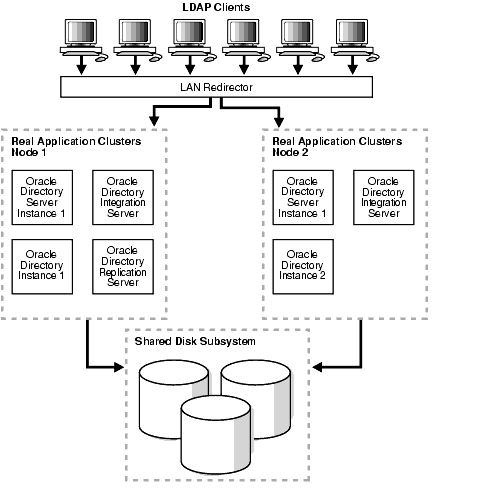The Oracle Directory Server in an Oracle9i Real Application Clusters Environment
To achieve a very comprehensive high availability configuration, you can configure Oracle Internet Directory to run in the Real Application Clusters active/active mode. This involves running Oracle Internet Directory processes and the Oracle Internet Directory-designated database on all the Real Application Clusters nodes.
Figure 29-1 shows a two-node cluster on which an Oracle9i Real Application Clusters database is configured.
Figure 29-1 Oracle Internet Directory with Basic High Availability Configuration

Text description of the illustration oidag110.gif
As Figure 29-1 shows:
- Oracle directory server instance 1 is active on Real Application Clusters Node 1 and Oracle directory server instance 2 is active on Real Application Clusters Node 2. Note that multiple Oracle directory server instances can be started on each node.
- Oracle directory integration and provisioning server instances are active on both nodes.
- The Oracle directory replication server instance is active on one node only. If the node fails, then the OID Monitor on the surviving node pulls the Oracle directory replication server instance from the failed node and starts it on the surviving node.
- The LDAP client applications can be configured to communicate with Oracle Internet Directory on different Real Application Clusters nodes directly. Alternatively, the Oracle Internet Directory server instances can be front-ended by a LAN redirector to get a single system image of the Real Application Clusters nodes.
- When one Real Application Clusters node is unavailable because of failure or maintenance purposes, Oracle Internet Directory on the other Real Applications Clusters node is available. The LDAP clients connected to Oracle Internet Directory on the failed Real Applications Clusters node must reconnect.

